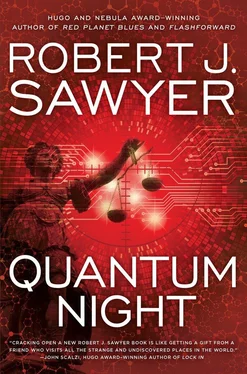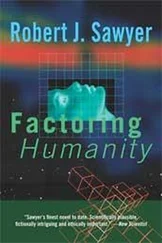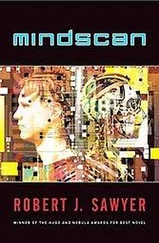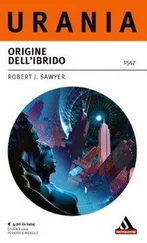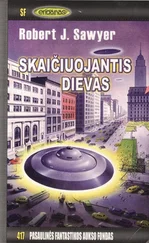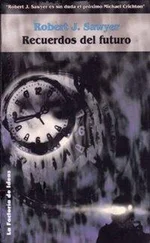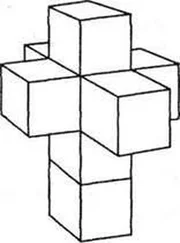I was clearly having an effect on her.
“I’m here all week,” she added, but her grin was way wider than her joke deserved. She started toward her study down the hall. “Come with me.”
* * *
“Look,” Kayla said, gesturing at her large desktop monitor. “That’s the simulation Victoria and I have been developing.” She had taken the seat in front of the computer, and I was crouching next to her.
“Yes?” I said.
“See? It’s looping.”
I thought that was a bad thing, from the handful of Word macros I’d tried to debug over the years; I was proud all out of proportion to the actual achievement of my one that turned MLA citations into APA format. “You mean it doesn’t terminate? It just keeps running?”
“No, no, no, the simulation stops just fine whenever we want it to. It’s not the program that’s looping; it’s the output.”
“What?”
She hit some keys, and a chart appeared on her screen. “Okay, look. These are the three possible quantum-superposition states: Q1, Q2, and Q3.”
“Right.”
“Well, Vic and I have been trying to solve that problem you discussed with her: you said my brother Travis started as a Q2—a quantum psychopath—got knocked down into a coma, and then came back up as a Q3 quick, right?”
“Right. He leveled up.”
“Exactly. But you started as a Q3, and, after being knocked into a coma back on New Year’s Eve 2000, you revived as a Q1—you leveled down, in other words; the exact opposite of Travis, right?”
“Right.”
“And I couldn’t square what the simulation was showing with the reality you’d reported. I had thought you’d gone Q3 to Q1 then bounced straight back to Q3—but you just told me that wasn’t what happened. You actually went Q3 to Q1, then to Q2, and then to Q3, one step at a time. And that’s exactly what the simulation predicts. See, what happened to you isn’t the opposite of what happened to Travis, it’s the same thing: each time you go down to the classical-physics state, you reboot, if you reboot at all, one level higher up— but the levels wrap around!” She pointed at her screen. “The math proves it: the change vector is a modulus, an absolute value. It statistically prefers being positive but, if that’s not possible, a negative delta occurs.”
“Um, so if you started as a Q1—”
“If you started as Q1, you’d come back from a coma as a Q2; if you were a Q2, like Travis, you’d come back as a Q3; and if you were originally a Q3, like you, you’d wrap around to being a Q1!”
“That’s—wow.”
“Wow indeed. But it’s exactly what the math predicts, and it’s exactly what happened to you and to my brother and to…” She trailed off.
“That’s fabulous, baby! You’re a genius.”
“Thanks,” she said, but she was frowning. “There’s still one problem, though. Somehow, while Trav was in a coma, the value of his previous superposition state had to be stored for nineteen years. For him to revive as a Q3, somewhere the fact that he’d previously been a Q2 had to be retained even when he was no longer in superposition.”
I’d been trying to come up to speed on all this. “Don’t almost all cells in the body have microtubular scaffolding? Not just brain cells? The ones in neurons are the ones Penrose and Hameroff implicated in consciousness, but maybe regular body cells might retain a degree of superposition even when neuronal tissue doesn’t. Kind of like muscle memory.”
I meant that last bit as a pun, but she nodded as if I were more clever than I really felt just then. “Maybe, maybe.” She shrugged a little. “Who knows? The bottom line is, whatever the mechanism, there clearly is such a memory.”
“Cool,” I said. “But, so are you saying this happens to anyone who completely loses consciousness? If they revive, they come up at one level higher than they were at before—or, if a Q3, wrap around to being a Q1, as I did?”
“Yes, I think so. But they have to actually have their brain drop into the classical-physics state. That doesn’t happen during sleep; sleeping is a conscious condition, which is why you dream and why external stimuli can wake you up.”
“True,” I said. “And, I’ve heard tons of stories about people who have temporarily lost consciousness through a coma, general anesthesia, or a near-death experience. Those who know them best often say they were changed by the experience. Family and friends say some people who have had NDEs are more mellow afterward—and, in many cases, they would be. If you were a psychopathic Q2 beforehand, you’d come back as a thoughtful, reflective Q3. And if you were a Q3 beforehand, you’d wrap around to being a Q1 p-zed, literally without a care in the world. Of course, that doesn’t happen with every case of general anesthesia, but—”
“Welllll,” said Kayla, “not to freak you out or anything, but a lot of the drugs we use in operations aren’t really anesthetics; that is, they don’t actually put you out cold. Rather, they’re paralytics that also inhibit memory formation. They keep you from moving during surgery, and they keep you from remembering all the pain, but they don’t actually put you out in the quantum-mechanical sense.”
“Holy shit. Really?”
“Uh-huh.”
“Wow. Well, thanks heaps. Something new to have nightmares about.”
She smiled contritely. “But there are groups that do suffer total knockouts disproportionately: boxers, football players, and so on. Most of the time it’s just— just! —a concussion. But every once in a while, one of them really is knocked out cold. And, you know, most of them probably started out as nice-enough guys. But everyone’s read those stories about some of them eventually turning into psychopaths, beating their spouses and so on.”
I nodded. One of the Green Bay Packers was in court just last week over having assaulted his wife.
“Anyway, that’s it!” said Kayla triumphantly. “That’s the pattern! Once you realize that the states wrap around, it’s simple. It’s elegant.”
* * *
I was asleep next to Kayla, but even when exhausted, I always dozed lightly, and a small change in the illumination filtering through my eyelids woke me up. Next to me, Kayla, naked, was thumb-typing on her phone.
“Texting your other lover?” I said; I was naked, too.
“No, no.” She continued typing furiously. “I’m sending myself a note. I thought of another mathematical proof that the states do in fact wrap around; I don’t want to forget it.” She tapped a little longer, then decisively banged the screen with her index finger and turned to me, illuminated by the phone, a satisfied smirk on her beautiful face.
I gently pulled her back down, so that she was facing me. I stroked her hair, its copper color undetectable in the darkness; stroked her shoulder, the skin smooth; worked my way toward her breast, perfect, round, soft, my palm moving in light circles over her nipple, which hardened; and then, sliding lower down her torso, touching the ridge that marked the leading edge of one of the wings on her blue butterfly tattoo.
The ridge; her scar.
I had one of my own, of course, on the left side of my chest, where that crazed addict’s knife—
No, no. It hadn’t been heart surgery; it had been the removal of a tumor in my breast. Above my sternum. No need to saw through bone.
And so no need—yes, yes: that was what Cassandra Cheung had told me over the phone from Calgary: “Says here they cut it out under a local anesthetic.”
Meaning I hadn’t had my consciousness shut off. I wasn’t knocked down to the classical-physics state then, back in February 2001—and so nothing had changed: I was a p-zed before the surgery and a p-zed afterward.
Читать дальше
